Leaderboard panel
What is a leaderboard panel?
A leaderboard panel is a panel that allows you to display several columns of information alongside each other so that you get a visual summary of any call information that interests you. Leader board panels are completely customisable and can show any combination of columns types. The background, font type, size, colour and placement are also customisable. Some examples are shown below:
The leaderboard panel allows you to display columns of call data comprising of call information you wish to monitor. The information showing in the leaderboard will update live, as soon as a call has logged in the system. The content of each column displayed is determined solely by your selection and the leaderboard can show any combination of columns types. The background, font type, size, colour and placement are also customisable.
The example below shows the following columns: the total number of calls, inbound, outbound, lost calls, duration of inbound, duration of outbound, total duration of calls and is ordered by total number of calls per user:
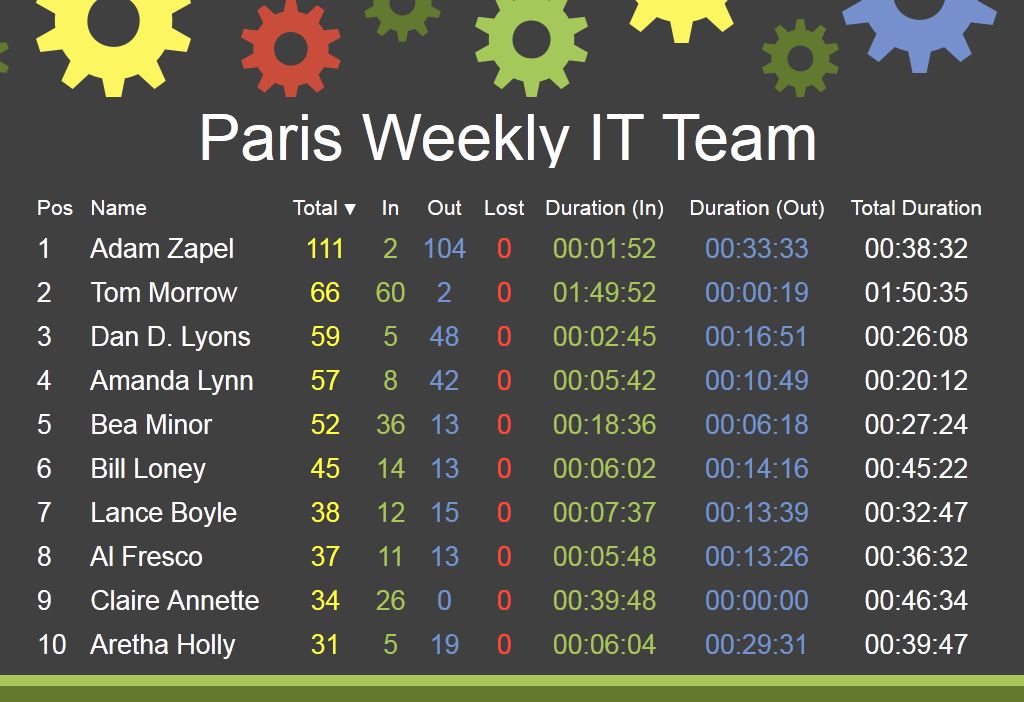
Adding a leaderboard panel
To add a leaderboard panel, click on the  button and then select the
button and then select the  button, as shown below:
button, as shown below:

The list of available panels types will disappear and the mouse pointer will transform in a white, cross-like pointer sign indicating where your panel will begin. Simply drag your mouse across the screen and you can size the panel, as shown below:
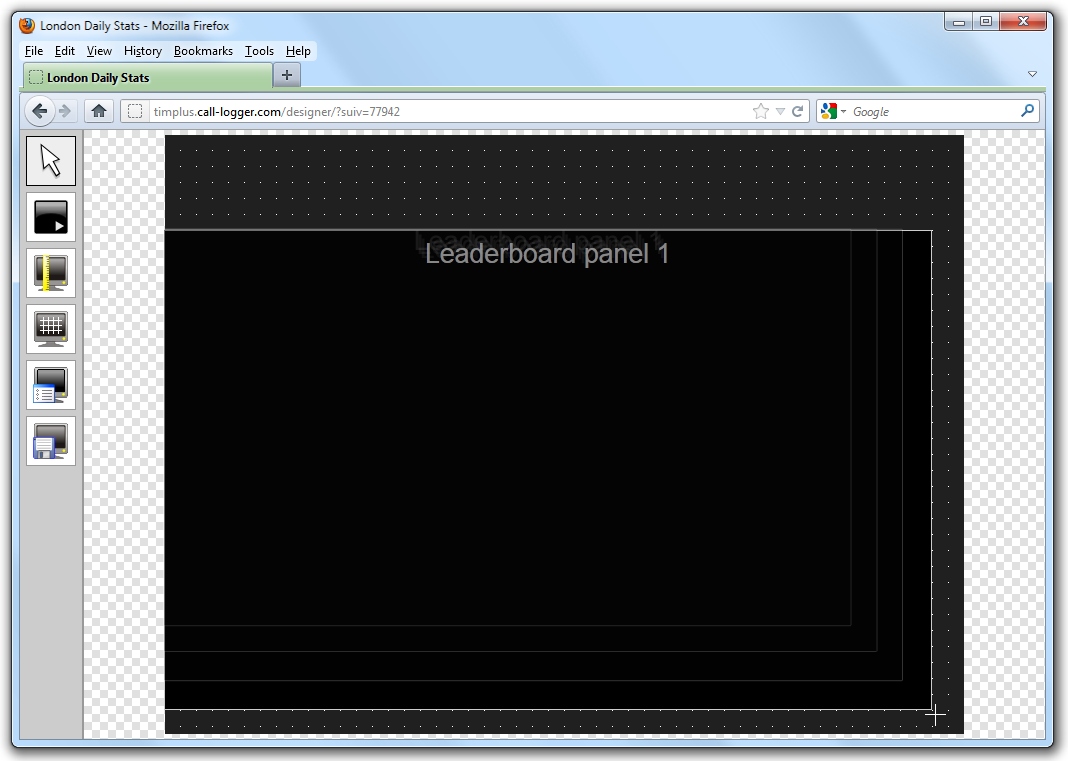
Customising a leaderboard panel
To customize your leaderboard panel, click on the  button on the top-left corner of the screen, then select the
button on the top-left corner of the screen, then select the  icon to customise the panel, as shown below:
icon to customise the panel, as shown below:
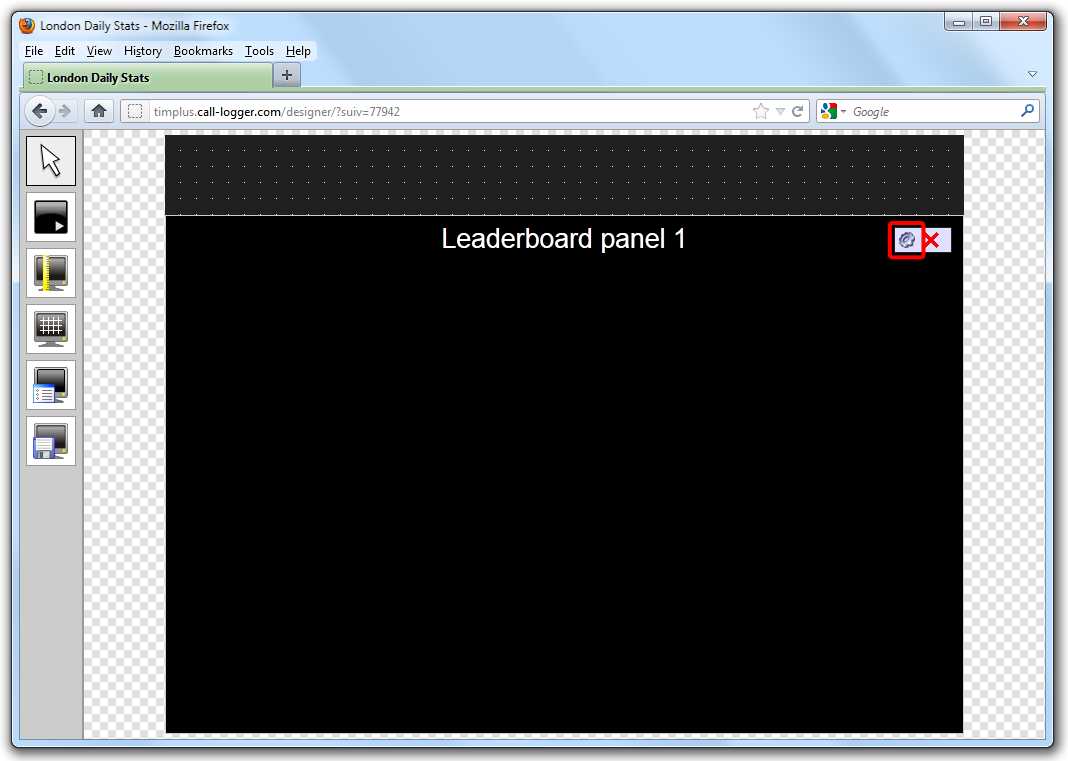
The following screen will appear:
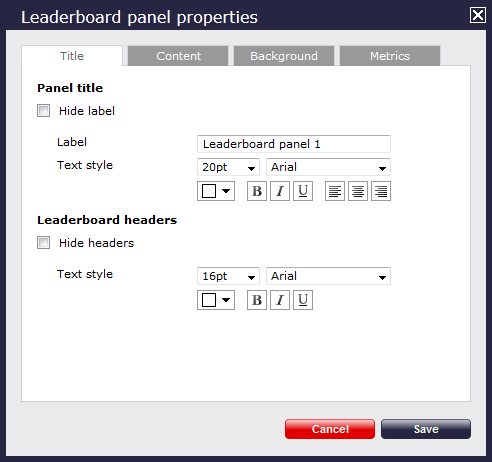
Title
The Title tab allows you to add add a name for your leaderboard and the headers for each column.
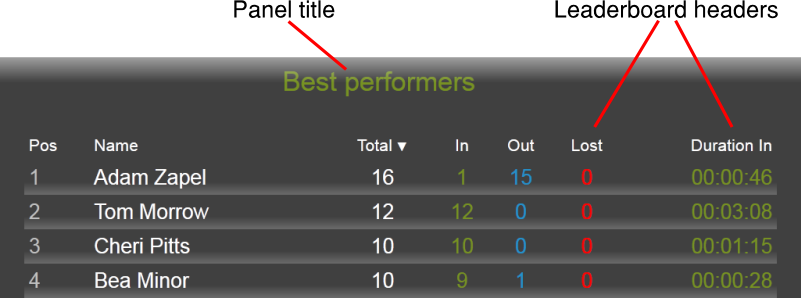
Adding Panel title
To provide a title for the leaderboard panel, simply fill in the Label field. Choose the font size you would like to use by selecting from the drop-down list provided. You can also choose the style of font you would like to use for your title.
To select the text colour, click on the drop-down arrow. This will display the colour palate available. To select a standard colour, all you need to do is click on it. To add a custom colour, click on one of the blank custom colour squares and type the RGB colour codes to add to your custom palette. You need to click on the button to set the chosen colour:

If you would like the text to appear as bold, italic or underlined, simply click on the required box to highlight  . To determine the placement of your title, simply click on
. To determine the placement of your title, simply click on  .
.
If the label panel on the top of the board is sufficient, you may not require a label on this panel, so you can click the Hide label box as shown below:
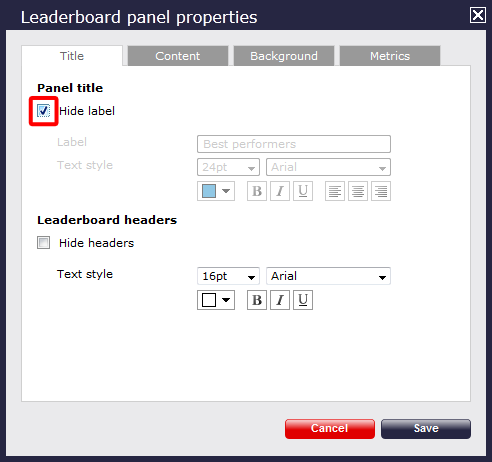
Adding Leaderboard headers
The default header for the columns in the Leaderboard panel is Arial, 16 point in white. However, you can change all the setting of the Leaderboard headers, that are similar to the Panel title ones. Click on the drop-down list alongside any of the properties to change.

Content
To add content to any leaderboard, select the tab.
First, you will need to select the stats point you wish to use, by clicking on the button, as shown below:
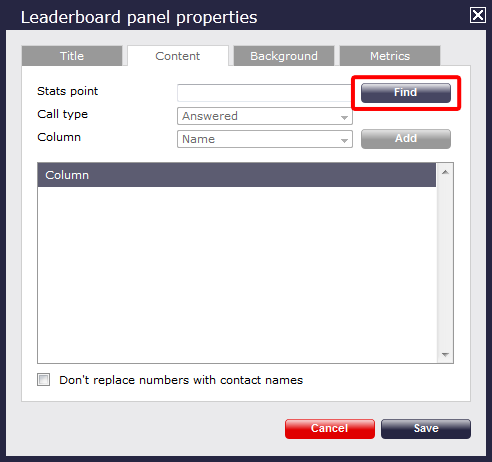
Next, you need to drill-down until you find the stats point you want to use, then click on the  button alongside it to select it, as shown below:
button alongside it to select it, as shown below:
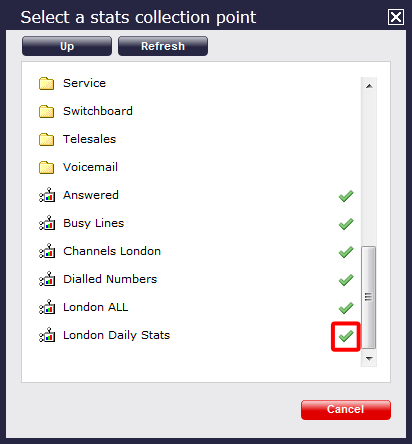
This will now appear as your chosen stats point. Next, you will need to decide what you would like to show on the leaderboard. To do this, work through the drop-down lists provided, and select the Call type and relevant Column to populate the panel.
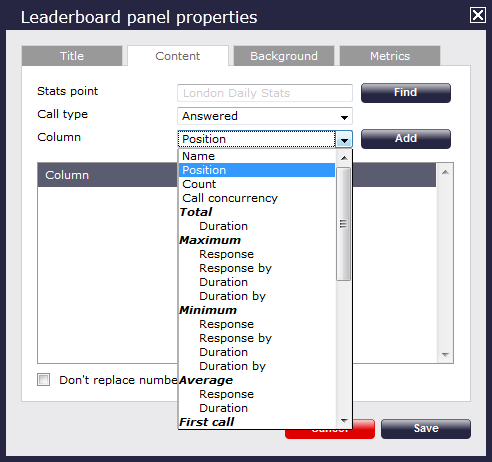
Once you select the Call type and relevant Column fields, press the button to add the column to the list, as shown below. Just repeat the same process to add as many columns as you like, according to your needs.
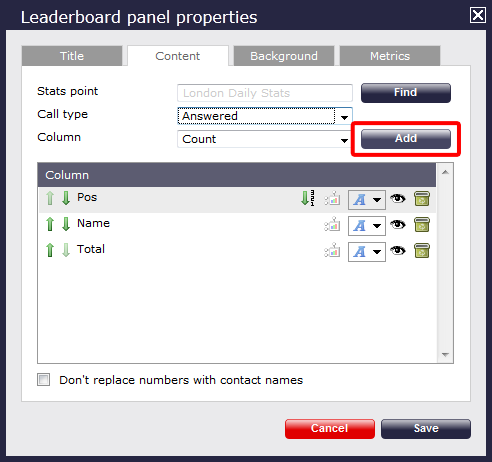
In the example below, we have selected the following settings for the Call type and its Column to form the columns that appear in the list:
- Pos: select Call type as 'All' and Column as 'Position'
- Name: select Call type as 'All' and Column as 'Name'
- Total: select Call type as 'All' and Column as 'Count'
- In: select Call type as 'Answered' and Column as 'Count'
- Out: select Call type as 'Outbound' and Column as 'Count'
- Lost: select Call type as 'Missed' and Column as 'Count'
- Duration In: select Call type as 'Answered' and Column as 'Average Duration'
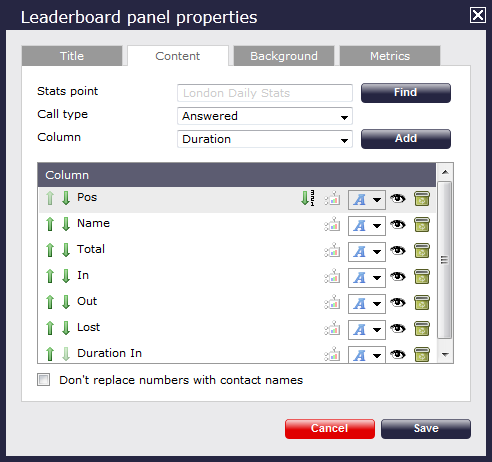
Changing column name
If you would like to change the name of any of the columns, click on the column name and overtype the current entry, highlighted in blue, then press the Enter key to save.
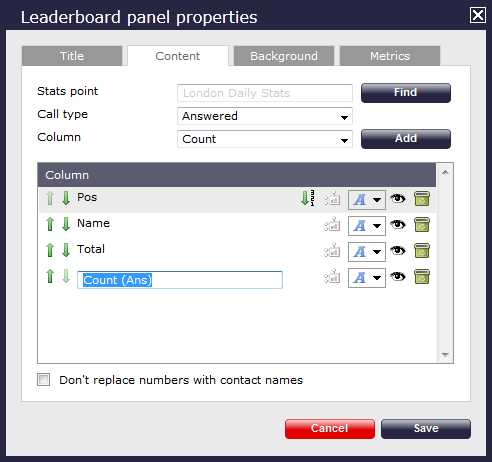
Rearranging columns
If you would like the columns to appear in a different order, just click on the  icon alongside its column. Moving a column up, by clicking on the
icon alongside its column. Moving a column up, by clicking on the  icon in the design mode, we basically move this column left on the board.
icon in the design mode, we basically move this column left on the board.
In the example below, we rearrange the In and Total columns. By clicking on the  icon next to the Total column, we move it a level up.
icon next to the Total column, we move it a level up.
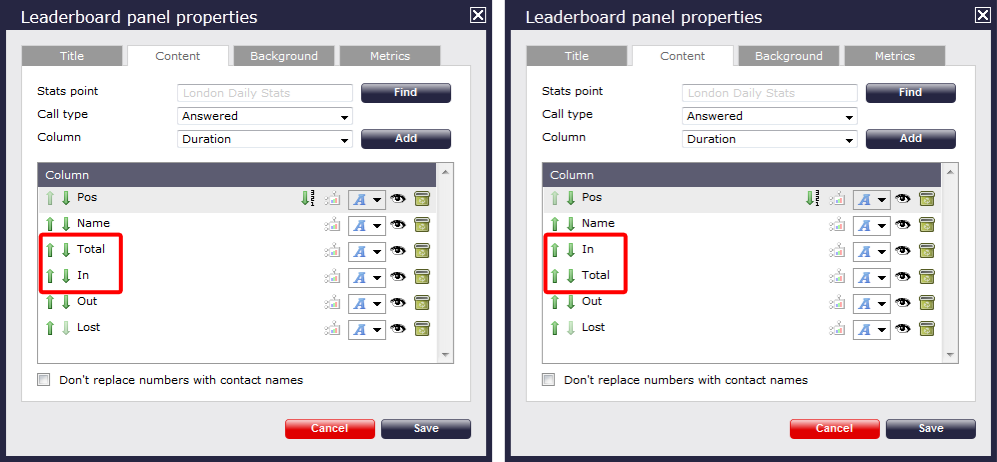
Changing a column's sorting
If you would like to sort the columns to appear in a specific order, click on the  icon alongside.
icon alongside.
In the example below, we change the sorting od the the Total column from descending to ascending. By clicking on the  icon alongside the Total column, we turn the sorting of this column to descending.
icon alongside the Total column, we turn the sorting of this column to descending.

Changing the stats collection point
To change the stats collection point of a column, click on the  icon alongside it which will automatically turn into
icon alongside it which will automatically turn into  to confirm that the stats point has changed. In the example below, we have clicked on the
to confirm that the stats point has changed. In the example below, we have clicked on the  icon to change the stats point of the In column.
icon to change the stats point of the In column.
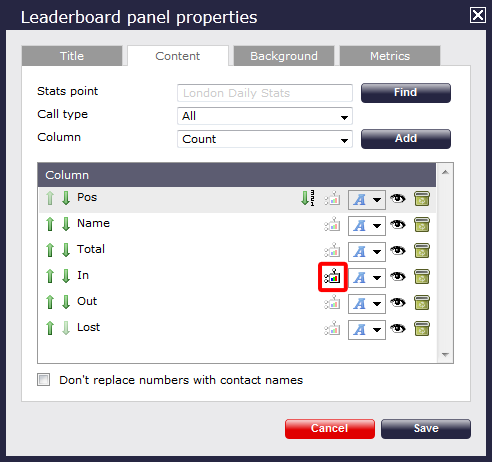
Once you click on the  icon the following pop-up window will appear. This will allow you to navigate up and down the Directory or choose a different stats point at the same point (e.g. "London ALL" instead of "London Daily Stats")
icon the following pop-up window will appear. This will allow you to navigate up and down the Directory or choose a different stats point at the same point (e.g. "London ALL" instead of "London Daily Stats")
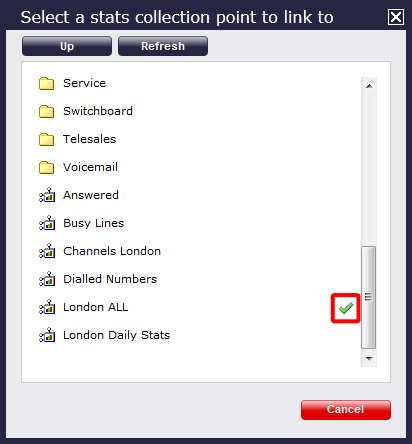
Changing Font properties
To change the font properties for any column, click on the  icon. The following pop-up will appear:
icon. The following pop-up will appear:

To choose the style of font or the font size, select from the drop-down list provided. To select the text colour, you need to click on the drop-down arrow. This will show the colour palette available. To select a standard colour, all you need to do is click on it. To add a custom colour, click on one of the blank custom colour squares and add the RGB colours to add to your custom palette. You need to click on the button to set the chosen colour.
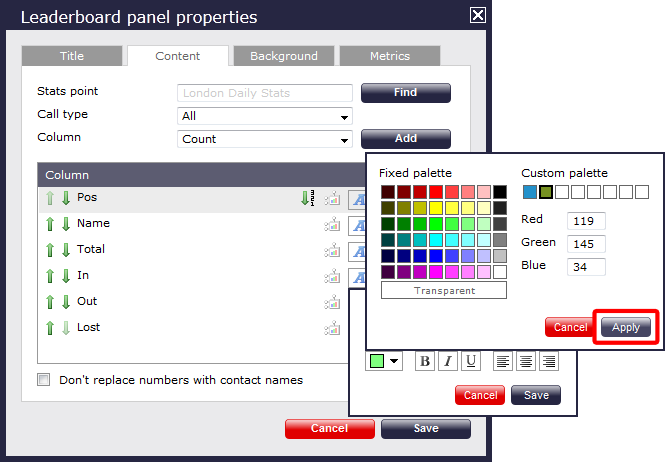
If you would like the text to appear as bold, italic or underlined, simply click on the required box to highlight  . To determine the placement of your title, simply click on
. To determine the placement of your title, simply click on  . At the end, click on thebutton to save any changes made.
. At the end, click on thebutton to save any changes made.
Hiding a column
In TIM Plus, you can temporarily hide the columns that you don't want to have in your display board. These may be occasions when for example you are running a particular campaign and you want to concentrate only on inbound or outbound calls. To hide a column, you simply click once on the  icon, which will automatically turn into
icon, which will automatically turn into  to confirm that the column is temporarily hidden, as shown below:
to confirm that the column is temporarily hidden, as shown below:
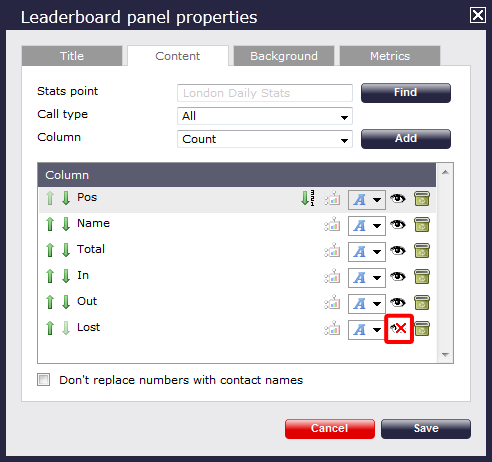
To display again, simply click once on the  icon which will automatically turn into
icon which will automatically turn into  .
.
Deleting a column
If you would like to permanently delete a column, then all you have to do is click on the  icon, as shown below:
icon, as shown below:
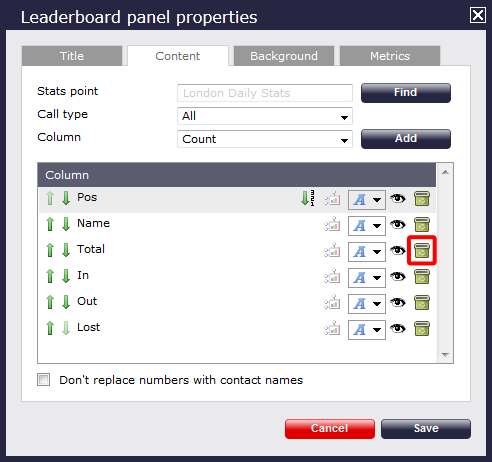
You will be asked to confirm deletion. Press if you are sure you want to delete the selected column.
Background
Click on the tab to configure the properties for the background of your label panel.
If you would like to add an image source, simply type the details in the box provided, as shown in the sceenshot below, otherwise leave blank. You can decide to repeat the image or centre it on the panel, by selecting from the drop-down list of the Image style field.
To select the background colour, click on the drop-down arrow; this will show the colour palette available. To select a standard colour, all you need to do is click on it. To add a custom colour, click on one of the blank custom colour squares and type in the RGB colour codes to add to your custom palette. You can also pick a transparent background, if you prefer. You will need to click on thebutton to set the chosen colour.
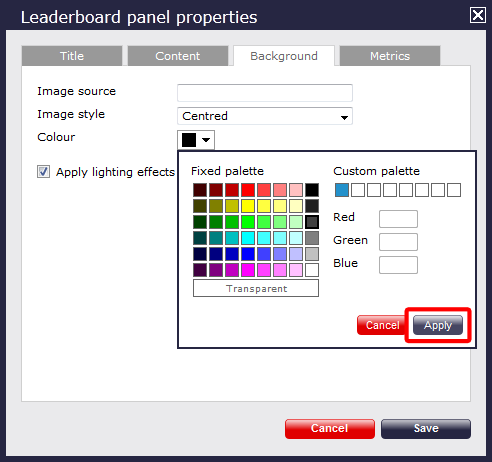
If you would like to apply lighting effects to the summary panel, tick the box provided, as shown below:

The two examples below show the difference between panels with and without lighting effects. The panel with the slight shine has a lighting effect applied, while the solid black panel hasn't.
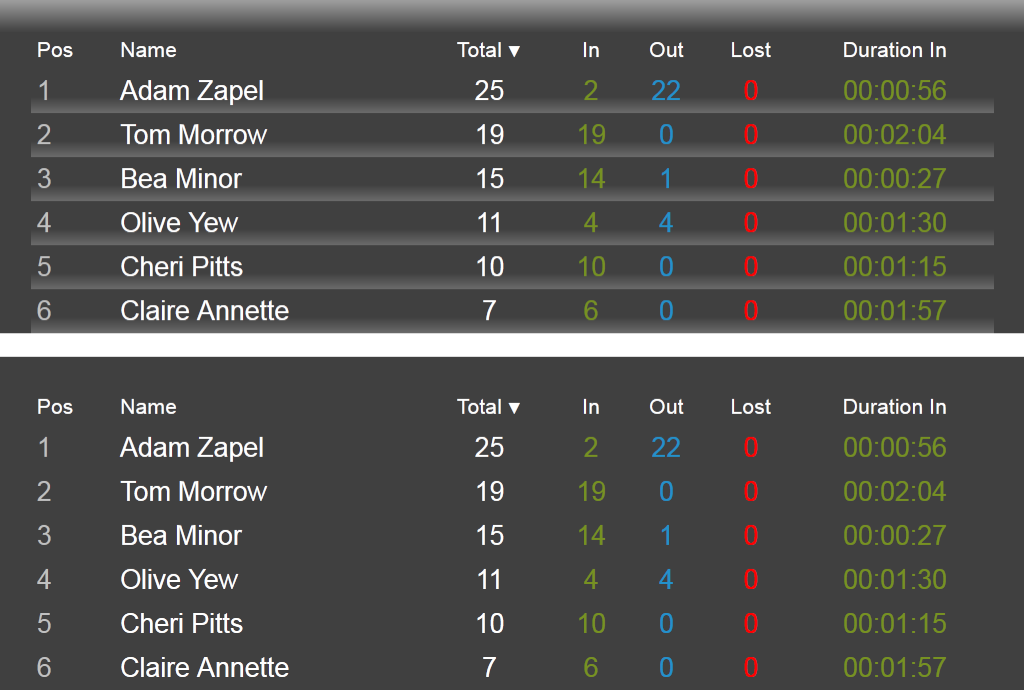
Metrics
To define the panel's metrics to suit your particular screen, type the required pixel sizes in the boxes provided. If you want to use automatic paging, select the available tick-box, as shown in the screenshot below. Alternatively, type in the number of rows you want your leaderboard to have per page, or select to view the first page only. If the leaderboard has more than one page, you can also set the rate at which you want the pages to change, by filliing in the Page speed box. At the end, click on thebutton to apply any changes made.
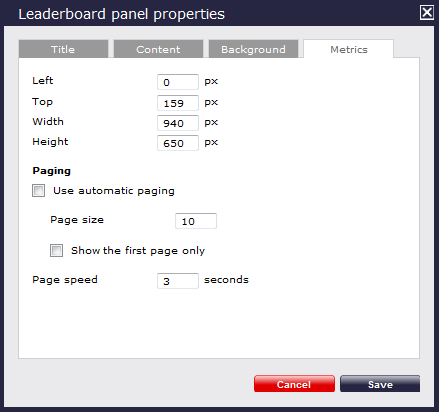
Leaderboard panel - overview video
For a live demonstration on how to design and customise a leaderboard panel, watch the video below: